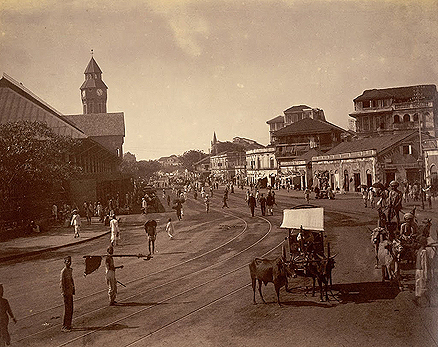
Photograph of Carnac Road, Bombay from the Macnabb Collection (Col James Henry Erskine Reid): Album of Miscellaneous views, taken by Deen Dayal in the 1880s. This is a view looking up Carnac Road with the Crawford Market on the left. Carnac Road was renamed Lokmanya Tilak Road. The busy port and industrial hub of Bombay is the capital of Maharashtra. During British rule, it was the administrative capital of the Bombay Presidency. Extending over a peninsula into the Arabian Sea on the west coast of India, Bombay prospered with maritime trade and became the chief commercial centre of the Arabian Sea. Originally a collection of fishing villages of the Koli community built on seven islands, Bombay was by the 14th century controlled by the Gujarat Sultanate who ceded it to the Portuguese in the 16th century. In 1661 it was part of the dowry brought to Charles II of England when he married the Portuguese princess Catherine of Braganza. By the 19th century, the British were in control of India and they embarked on a programme of building commensurate with their power and primacy. Bombay burgeoned over the decades and boasted a skyscape of colonial architecture.
No comments:
Post a Comment